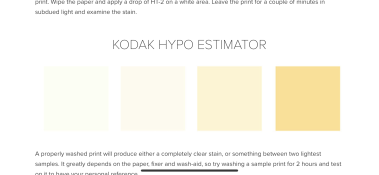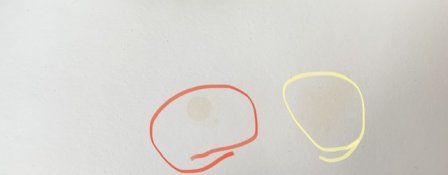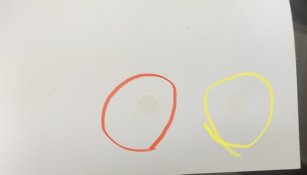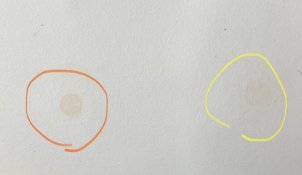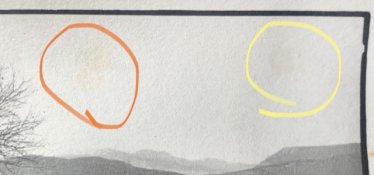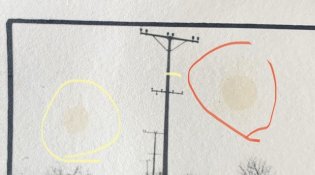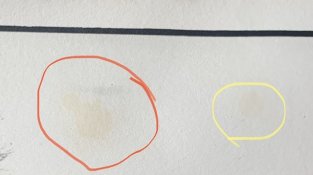NB23
Member
- Joined
- Jul 26, 2009
- Messages
- 4,307
- Format
- 35mm
Hello dear knowledgeable people.
I’m very perplexed and I don’t feel like starting over 400 prints that I have just finished.
I usually overwash my fiber prints and my HT-2 test prove it with results regularly in the 0-1 (Zero-to-One) grade scale.
Yes, depending on which paper you use, even a grade-2 result can be accepted as an archival wash.
However, this is my problem: Ilford Art-300 paper floats like crazy and the papers tend to stick together. And combine to that the fact that we have a curfew that has been forcing me to hurry up, I ended up washing the prints only 30 minutes versus the usual 1.5-2 hours I am used to.
Yes, the Ilford and Kodak recomendations are far below 30 minutes washing when a Hypo clearing agent is used, but I just can’t trust their recomendation of a 10 minutes wash.
Anyhow, this has been my workflow for the past 400 sheets of ilford art-300:
-fix in bath 1
-fix bath 2
-water holding bath
-when all the prints are done, I rinse all the prints for 5 minutes
-Viradon toning for maximum archival
-rinse the prints
-10 minutes Kodak Hypo clear
-wash 30 minutes. I would love to wash for 1 hour but the curfew cuts my time. I’d also love to leave the prints soaking overnight as I do with FB prints but Ilford strongly suggests a 30-45 minutes wash with a maximum of 45 minutes soak time. And if a Hypo eliminator is used, they recomend a 10 minutes wash.
I sometimes wash the prints back to back and they stick together, which can prevent a good wash.
With my method above, my HT-2 tests gives me a stain corresponding to grade 2.5/3 (I do get the occasional grade 1 but let’s stick to a grade 3 for the sake good measure).
Although a grade 3 can be acceptable for a few papers, according to Kodak litterature, I am not very happy about this.
My question: if my prints have a grade-2.5/3 stain (see attached photo for the scale in question), but they are Toned in viradon (polysulfide toner), are the prints well protected?
I’m ambivalent because on one side a toned print will be protected from an frame matboard containing acid, but on the other side if the print itself has some acid left, how can the silver image on which it rests resist it in the long run?
So, what says you, oh experts? Good for 100 years?
I’m very perplexed and I don’t feel like starting over 400 prints that I have just finished.
I usually overwash my fiber prints and my HT-2 test prove it with results regularly in the 0-1 (Zero-to-One) grade scale.
Yes, depending on which paper you use, even a grade-2 result can be accepted as an archival wash.
However, this is my problem: Ilford Art-300 paper floats like crazy and the papers tend to stick together. And combine to that the fact that we have a curfew that has been forcing me to hurry up, I ended up washing the prints only 30 minutes versus the usual 1.5-2 hours I am used to.
Yes, the Ilford and Kodak recomendations are far below 30 minutes washing when a Hypo clearing agent is used, but I just can’t trust their recomendation of a 10 minutes wash.
Anyhow, this has been my workflow for the past 400 sheets of ilford art-300:
-fix in bath 1
-fix bath 2
-water holding bath
-when all the prints are done, I rinse all the prints for 5 minutes
-Viradon toning for maximum archival
-rinse the prints
-10 minutes Kodak Hypo clear
-wash 30 minutes. I would love to wash for 1 hour but the curfew cuts my time. I’d also love to leave the prints soaking overnight as I do with FB prints but Ilford strongly suggests a 30-45 minutes wash with a maximum of 45 minutes soak time. And if a Hypo eliminator is used, they recomend a 10 minutes wash.
I sometimes wash the prints back to back and they stick together, which can prevent a good wash.
With my method above, my HT-2 tests gives me a stain corresponding to grade 2.5/3 (I do get the occasional grade 1 but let’s stick to a grade 3 for the sake good measure).
Although a grade 3 can be acceptable for a few papers, according to Kodak litterature, I am not very happy about this.
My question: if my prints have a grade-2.5/3 stain (see attached photo for the scale in question), but they are Toned in viradon (polysulfide toner), are the prints well protected?
I’m ambivalent because on one side a toned print will be protected from an frame matboard containing acid, but on the other side if the print itself has some acid left, how can the silver image on which it rests resist it in the long run?
So, what says you, oh experts? Good for 100 years?
Attachments
Last edited:





